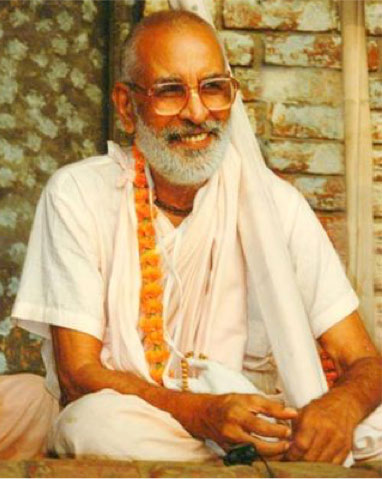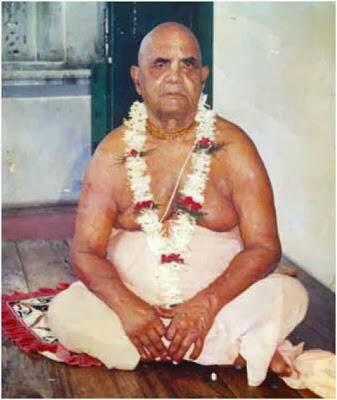sri sri guru gauranga jayatah!

Year 2, Issue 1, Amāvasyā
Speical Edition
Posted: 24 January 2019
Dedicated to and Inspired by
nitya-lila pravista om visnupada
Śrī Śrīmad Bhaktivedānta Nārāyaṇa Gosvāmī Māhārāja
An Offering of Transcendental Memories
of prapūjya-caraṇa aṣṭottara-śata-śrī
Śrīmad Bhakti Jīvana Janārdana Gosvāmī Mahārāja
Part Two

(6)
[His special affection for me and his extraordinary anuraga for kṛṣṇa-kathā]
Whenever he would see me, he would shower me with an affection that had a simple, natural intimacy (laukika-sadbandhuvat). As much as possible, he did not like dealings that were filled with giving him honour (maryādā). When we would meet each other, he would grab my hands and have me sit on a seat that was the same level as his seat. He wouldn’t even hesitate to have me sit on his own bed.
Towards the end of his life, he spent some days in Kolkata for treatment. After Śrīdhāma Navadvīpa parikramā in 1994, I went to have his darśana with Śrīmān Banavārī Lāl Siṁhānīyā and a few brahmacārīs. We all offered prostrated obeisance to him. Immediately upon seeing me, despite the doctor’s prohibition and my repeated request, he got off his bed, offered daṇḍavat-praṇāma, took hold of my hand, and made me sit beside him on his bed. Remembering topics of his ārādhyā-devī, Śrīmatī Rādhikā, tears welled in his eyes and he began to cry, “Alas, alas! I have not been able to perform any sādhana-bhajana.”
Seeing his state of bhāva, everyone became overwhelmed with emotion, and the pond of our eyes become filled with tears. Forgetting his illness, he began an iṣṭa-goṣṭhī on the topic of Śrīmatī Rādhikā’s compassion (karunā). Seeing his extraordinary deep attachment (anurāga) to kṛṣṇa-kathā, we were all stunned.

(7)
[Śrīmatī Rādhikā, Śrī Kṛṣṇa’s topmost beloved]
Every year, without fail, he would attend the Śrīdhāma Navadvīpa parikramā conducted by Śrī Gauḍīya Vedānta Samiti, as well as [the Samiti’s] parikramās of Vraja-maṇḍala, Kṣetra-maṇḍala, Dvārakā, South India and other places. He used to say, “The most worshipable Śrī Śrīmad Bhakti Prajñāna Keśava Gosvāmī Mahārāja has given an invitation to me for all the time saying, ‘You must certainly come for all of our functions.’ ”
For this reason, even after my gurudeva entered aprakaṭa-līla, every year pūjyapāda Janārdana Mahārāja would unfailingly participate in Śrīdhāma Navadvīpa parikramā and Vraja-maṇḍala parikramā. 1993 was his last Vraja-maṇḍala parikramā. When the parikramā arrived at Śrī Paiṭhā-grāma near Govardhana, he spoke about that place.
“This Paiṭhā-grāma is an extra special place for Gauḍīya Vaiṣṇavas. Nearby at Candra-sarovara, when, at the time of rāsa, Kṛṣna disappeared, Kṛṣṇa’s beloveds became maddened with feelings of separation from Him and searched for Him here and there. Some asked the birds and animals of Kṛṣṇa’s whereabouts, and some inquired from the trees and vines. Some vraja-ramaṇīs thought themselves to be Kṛṣṇa and others thought themselves to be Pūtanā, Śakaṭāsura, Aghāsura, etc. In this way, they would become maddened in the anubhāva named līlā [enactment of Kṛṣṇa’s pastimes]. At that time, Kṛṣṇa manifested before them in the form of four-handed Vāsudeva. At first, the different gopīs who saw this form while searching for Kṛṣṇa offered Him praṇāma, understanding Him to be Nārāyaṇa, and then moved on, taking no notice Him. But as soon as Śrī Kṛṣṇa saw Śrīmatī Rādhikā, He became incapable of maintaining His Nārāyaṇa form. Upon seeing Her, He appeared before Her in His own svarūpa, that is, the svarūpa of Vrajendra-nandana. It was thus proven at this place that among all the gopa-ramaṇīs, Śrīmatī Rādhikā is the topmost beloved of Kṛṣṇa. ‘Yathā rādhā priyā viṣṇos, tasyāḥ kuṇḍaṁ priyaṁ tathā / sarva-gopīṣu saivaikā, viṣṇor atyanta-vallabhā – Just as Śrīmatī Rādhikā is most dear to Śrī Kṛṣṇa, Her pond, Śrī Rādhā-kuṇḍa, is equally dear to Him. Among all the beloved gopīs, none are as dear as Śrīmatī Rādhikā’ (Padma Purāṇa).”
Upon hearing this deliberation, everyone became charmed.
(8)
[Defying the resident Rādhā-kuṇḍa bābājīs]
When on this parikramā, we reached Rādhā-kuṇḍa he addressed the resident Śrī Rādhā-kuṇḍa bābājīs, saying, “You are all erudite persons, you have given up everything and have become penniless, and you are performing bhajana in Rādhā-kuṇḍa and Vṛndāvana. All of you please come [and speak with us]. Why do you slander and criticize the followers of Śrīla Sarasvatī Ṭhākura? Why do you say that saffron coloured cloth, sannyāsa and so on are divergent from the bhajana of the Gauḍīya Vaiṣṇavas? We Gauḍīya Vaiṣṇavas garbed in saffron colour humbly desire to discuss this. All of you, please come here and discuss this topic with us.”
Quoting a verse and the commentary of Bṛhad-bhāgavatāmṛta (2.7.14) he gave proof of the following:
yat-pāda-paṅkaja-palāśa-vilāsa-bhaktyā
karmāśayaṁ grathitam udgrathayanti santaḥ
tadvan na rikta-matayo yatayo ’pi ruddha-
sroto-gaṇās tam araṇaṁ bhaja vāsudevam
Śrīmad-Bhāgavatam (4.22.39)
[Devotees of Śrī Bhagavān, who remain perpetually engaged in serving the toes of His lotus feet, can eliminate with ease the strong knot of yearning to enjoy the fruits of one’s prescribed duties. This task cannot be performed by those who are not devoted to Him, such as jñānīs and yogīs, despite their attempt to put an end to the swelling waves of sense enjoyment. You are thus advised to perform bhajana of Śrī Kṛṣna, the son of Vasudeva.]
kibā vipra, kibā nyāsī, śūdra kene naya
jei kṛṣṇa-tattva-vettā, sei ‘guru’ haya
Śrī Caitanya-caritāmṛta (Madhya-līlā 8.128)
[Whether one is a brāhmaṇa, a sannyāsī or a śūdra, if he is conversant with transcendental knowledge about Śrī Kṛṣṇa, he can become a guru.]
[He went on to say,] “The nine roots of Śrīman Mahāprabhu’s wish-fulfilling tree of prema are all sannyāsīs who wore saffron-coloured cloth: Śrī Paramānanda Purī, Śrī Keśava Bhāratī, Śrī Brahmānanda Purī, Śrī Brahmānanda Bhāratī, Śrī Viṣṇu Purī, Śrī Keśava Purī, Śrī Kṛṣṇānanda Purī, Śrī Nṛsiṁha Tīrtha, and Śrī Sukhānanda Purī. Śrīman Nityānanda Prabhu, Svarūpa Dāmodara and others were all sannyāsīs. Even sannyāsīs wearing saffron coloured cloth are seen among the Śrī Rādhā-ramaṇa Gosvāmīs – both Gosvāmīs in times gone by and also in current times. Please come and speak with us; please deliberate on this. If we have any fault or defect, please explain it to us.”
Hearing his loud roaring in this way, not a single bābājī came before him. The approximately six to seven hundred people who were listening to his excellent conclusive statements, deeply understood in truth and essence that the conceptions of the Sarasvata Gauḍīya Vaiṣṇavas [the line of Śrīla Bhaktisiddhānta Sarasvatī Prabhupāda] alone are immaculate and fully and perfectly conclusive.
(9)
[Gopīśvara Mahādeva awards kṛṣṇa-prema]
One time, on Śrī Vraja-maṇḍala parikramā at Nandīśvara Parvata in Śrī Nandagrāma, there was an iṣṭa-goṣṭhī on the topic of śiva-tattva, and it was apparent that devotees held different opinions. In that assembly, I had said that Śrī Sadāśiva is viṣṇu-tattva. His non-different form in Vṛndāvana is Gopīśvara Mahādeva; in Govardana it is Cakleśvara Mahādeva; in Nanda-grāma, it is Nandīśvara Mahādeva and in Kāmyavana it is Kāmeśvara Mahādeva. All of these forms of his are completely identical, divine existential reality (tattva). Śrīmad-Bhāgavatam says in reference to Śiva, “vaiṣṇavānāṁ yathā śambhu – Śrī Śiva is the greatest Vaiṣṇava.” He is the greatest friend of Śrī Sanātana Gosvāmī, who, in Hari-bhakti-vilāsa, has even given the process for worshipping him. Even his praṇāma-mantra says:
vṛndāvanāvani-pate jaya soma soma-maule!
sanaka-sanandana-sanātana-nāradeḍya
gopīśvara! vraja-vilāsi-yugāṅghri-padme
prema prayaccha nirupādhi namo namas te
[O protector of the land of Vṛndāvana, O husband of Umā, O Soma-mauli, you who carry the moon on your head! O you who are worshipped by Sanaka, Sanandana, Sanātana, and Nārada! O Gopīśvara, please bestow upon me unconditional prema for the lotus feet of Śrī Śrī Rādhā-Kṛṣṇa, who perform loving pastimes in Vraja.]
“Therefore, Gopeśvara Mahādeva is worshipable for the Vaiṣṇavas. By his merciful blessing, one is able to obtain vraja-bhakti.”
Hearing this, a few Vaiṣṇavas present took a contending stance. “There is no place in the Śrī Gauḍīya Vaiṣṇava sampradāya to worship Śaṅkara” they said. “He cannot give vraja-prema.”
In that assembly, pūjyapāda Janārdana Mahārāja quoted the following śloka from Śrīla Raghunātha Gosvāmī’s Śrī Vraja-vilāsa-stava (87):
mudā gopendrasyātmaja-bhuja-pariṣvaṅga-nidhaye
sphurad-gopī-vṛndair yam iha bhagavantaṁ praṇayibhiḥ
bhajadbhis tair bhaktyā svam abhilaṣitaṁ prāptam acirād
yamī-tīre gopīśvaram anudinaṁ taṁ kila bhaje
[To obtain the jewel of being embraced by the arms of Vrajendra-nandana Śyāmasundara, the gopīs, who possess firm, loving, intimate attachment for Śrī Kṛṣṇa, joyfully worshipped Gopīśvara Mahādeva (Sadāśiva) with great devotion and had all their internal desires fulfilled without delay. Daily I worship that Gopīśvara Mahādeva who resides on the bank of the Yamunā.]
In this way, he cleared any confusion on this topic. “The vraja-gopīs pray to Gopīśvara Mahādeva to obtain kṛṣṇa-prema, and that Gopīśvara Mahādeva awards this kṛṣṇa-prema. There is therefore no more room to doubt that Gopīśvara Mahādeva bestows the cherished objective of the Gauḍīya Vaiṣṇavas. For this reason, each and every one of us pray to him for his mercy.”
Both parties were satisfied with his conclusion.
(10)
[The meaning of the word “samādhi”]
One time, pūjyapāda Janārdana Mahārāja asked my guru-pādapadma, nitya-līlā-praviṣṭa oṁ viṣṇupāda Śrīla Bhakti Prajñāna Keśava Gosvāmī Mahārāja, about the Vaiṣṇavas’ explanation of the word samādhi. He said, “Vaiṣṇavas explain the word samādhi in various ways, but their explanations have not satisfied my mind. Please enlighten me about the meaning of this word.”
My guru-pādapadma said, “Samādhi means to become sama-dhī, acquainted with the inner-desire of one’s object of worship (upāsya-tattva). In this way, saturated in that mood (bhāva), one engages oneself fully in service to that [object of worship]. The damsels of Vraja naturally remain in a constant state of samādhi. At the time of their auspicious departure, the transcendental, perfected body (siddha-śarīra) of the Vaiṣṇavas becomes spiritually the same as that of their object of service (sevyā), and they fully dedicate themselves in service to their sevyā in every way. This is the true meaning of the word samādhi.”
Upon hearing this answered so concisely, pūjyapāda Janārdana Mahārāja became extremely delighted.
(11)
[His niṣṭhā in Śrīla Prabhupāda]
On the day of Śrī Māyāpura parikramā during Śrī Vedānta Samiti’s Śrī Navadvīpa-dhāma parikramā, pūjyapāda Janārdana Mahārāja would arrive at the samādhi of his most worshipful nitya-līlā-praviṣṭa Śrīla Prabhupāda and extol Śrīla Prabhupāda’s glories. As he would do so, his throat would choke up, he would become overwhelmed with emotion and unable to speak further. He could only weep, tears flowing from his eyes. Beholding such bhāva and guru-niṣṭhā, the audience would become overwhelmed.
In this way, many divine memories of him are appearing in my heart, but I fear increasing the length of this essay. I therefore offer hundreds and hundreds of flowers from my heart at his divine feet. My only prayer at his lotus feet is that he may cleanse my hundreds and hundreds of faults, shortcomings and offences and thus count me among the recipients of his mercy.
Praying for a particle of mercy from
Śrī Guru and the Vaiṣṇavas,
Tridaṇḍi-bhikṣu Śrī Bhaktivedānta Nārāyaṇa
Translated by the Rays of The Harmonist team
from the Viraha-smāraka-prakāśana